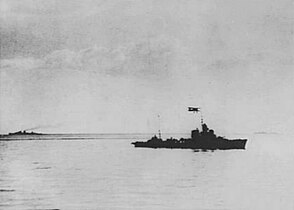
Operation Pedestal, known in Malta as Il-Konvoj ta' Santa Marija, was a British operation to carry supplies to the island of Malta in August 1942, during the Second World War.

The Battle of Calabria known to the Italian Navy as the Battle of Punta Stilo, was a naval battle during the Battle of the Mediterranean in the Second World War. Ships of the Regia Marina were opposed by vessels of the Mediterranean Fleet. The battle took place 30 nmi to the east of Punta Stilo, Calabria.
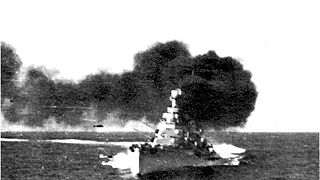
The Battle of Cape Spartivento, known as the Battle of Cape Teulada in Italy, was a naval battle during the Battle of the Mediterranean in the Second World War, fought between naval forces of the Royal Navy and the Italian Regia Marina on 27 November 1940.

The Second Battle of Sirte was a naval engagement in the Mediterranean Sea, north of the Gulf of Sidra and south-east of Malta, during the Second World War. The escorting warships of a British convoy to Malta held off a much more powerful squadron of the Regia Marina. The British convoy was composed of four merchant ships, escorted by four light cruisers, one anti-aircraft cruiser and 17 destroyers. The Italian force comprised a battleship, two heavy cruisers, one light cruiser and ten destroyers. Despite the British success at warding off the Italian squadron, the Italian fleet attack delayed the convoy's planned arrival before dawn, which exposed it to intense air attacks that sank all four merchant ships and one of the escorting destroyers in the following days.

The naval Battle of Cape Bon took place on 13 December 1941 during the Second World War, between two Italian light cruisers and an Allied destroyer flotilla, off Cape Bon in Tunisia.

The First Battle of Sirte was fought between forces of the British Mediterranean Fleet and the Regia Marina during the Battle of the Mediterranean in the Second World War. The engagement took place on 17 December 1941, south-east of Malta, in the Gulf of Sirte. The engagement was inconclusive as both forces were protecting convoys and wished to avoid battle.

Operation Collar was a small, fast three-ship convoy during the Second World War. The convoy left Britain on 12 November 1940 and passed Gibraltar on 24 November, escorted by two cruisers, two ships for Malta and one bound for Alexandria. Numerous other operations took place partly as diversions and the Italian Fleet sailed to attack British ships, leading to the inconclusive Battle of Cape Spartivento on 27 November. The two merchant ships reached Malta on 26 November.

Operation Stoneage or Operation Stone Age was an Allied convoy operation to the Mediterranean island of Malta in the Second World War. To disguise the destination of the ships, some took on their cargo at Port Sudan in the Red Sea. The four ships of Convoy MW 13 sailed from Alexandria on 16 November, escorted by cruisers, destroyers and round-the-clock air cover from captured airfields in Egypt and Cyrenaica.

The Malta convoys were Allied supply convoys of the Second World War. The convoys took place during the Siege of Malta in the Mediterranean Theatre. Malta was a base from which British sea and air forces could attack ships carrying supplies from Europe to Italian Libya. Britain fought the Western Desert Campaign against Axis armies in North Africa to keep the Suez Canal and to control Middle Eastern oil. The strategic value of Malta was so great the British risked many merchant vessels and warships to supply the island and the Axis made determined efforts to neutralise the island as an offensive base.

Operation Harpoon was one of two simultaneous Allied convoys sent to supply Malta in the Axis-dominated central Mediterranean Sea in mid-June 1942, during the Second World War. Operation Vigorous was a west-bound convoy from Alexandria and Operation Harpoon was an east-bound convoy operation from Gibraltar.

Operation Vigorous was a British operation during the Second World War, to escort supply Convoy MW 11 from the eastern Mediterranean to Malta, which took place from 11 to 16 June 1942. Vigorous was part of Operation Julius, a simultaneous operation with Operation Harpoon from Gibraltar and supporting operations. Sub-convoy MW 11c sailed from Port Said (Egypt) on 11 June, to tempt the Italian battlefleet to sail early, use up fuel and be exposed to submarine and air attack. Convoy MW 11a and Convoy MW 11b sailed next day from Haifa, Port Said and Alexandria; one ship was sent back because of defects. Italian and German (Axis) aircraft attacked Convoy MW 11c on 12 June and a damaged ship was diverted to Tobruk, just east of Gazala. The merchant ships and escorts rendezvoused on 13 June. The British plans were revealed unwittingly to the Axis by the US Military Attaché in Egypt, Colonel Bonner Fellers, who reported to Washington, D.C. in "Black"-coded wireless messages; it was later discovered that the Black Code had been broken by the Servizio Informazioni Militare.
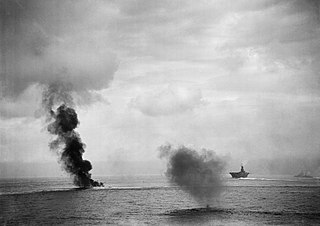
Operation Halberd was a British naval operation that took place on 27 September 1941, during the Second World War. The British were attempting to deliver a convoy from Gibraltar to Malta. The convoy was escorted by several battleships and an aircraft carrier, to deter interference from the Italian surface fleet, while a close escort of cruisers and destroyers provided an anti-aircraft screen.
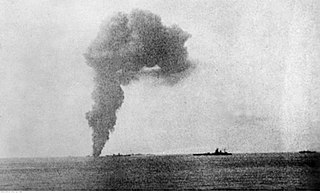
Operation Substance was a British naval operation in July 1941 during the Second World War to escort Convoy GM 1, the first of the series from Gibraltar to Malta. The convoy, escorted by Force H, was attacked by Italian submarines, aircraft and MAS boats.

The Battle of the Tarigo Convoy was a naval battle of the Second World War, part of the Battle of the Mediterranean. It was fought on 16 April 1941, between four Royal Navy destroyers and three Italian destroyers of the Regia Marina which were escorting a convoy near the Kerkennah Islands off Sfax, on the Tunisian coast.

The Battle of the Duisburg Convoy was fought on the night of 8/9 November 1941 between an Italian convoy, its escorts and four British ships. The convoy was named BETA by the Italian naval authorities and carried supplies for the Italian Army civilian colonists and the Afrika Korps in Italian Libya.

The Battle of Skerki Bank was an engagement during the Second World War which took place near Skerki Bank in the Mediterranean Sea in the early hours of 2 December 1942. Force Q, a flotilla of Royal Navy cruisers and destroyers, attacked Convoy H, an Italian convoy and its Regia Marina escort of destroyers and torpedo boats.

The Battle of the Espero Convoy on 28 June 1940, was the first surface engagement between Italian and Allied warships of the Second World War. Three 36 kn Italian destroyers made a dash from Taranto for Tobruk in Libya to transport Blackshirt anti-tank units, in case of an armoured attack from Egypt by the British.
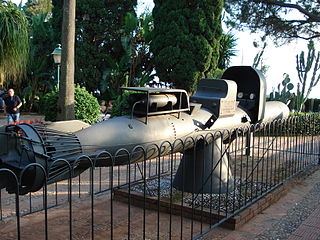
The Raid on Alexandria was carried out on 19 December 1941 by Italian Navy divers of the Decima Flottiglia MAS, who attacked and sank two Royal Navy battleships at their moorings and damaged an oil tanker and a destroyer in the harbour of Alexandria, Egypt, using Siluro Lenta Corsa manned torpedoes.
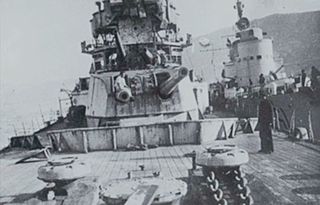
The Raid on Souda Bay was an attack by the Decima MAS (X-MAS), a specialist unit of the Regia Marina that used unconventional weapons. Decima MAS used explosive boats (MTM) against British ships lying in Souda Bay, Crete, during the early hours of 26 March 1941. The MTM explosive boats had been ferried from Astypalaia by the destroyers Francesco Crispi and Quintino Sella and launched at the approaches to the bay. After crossing the three boom defences, the MTM attacked the British heavy cruiser HMS York and the Norwegian tanker Pericles (8,324 GRT).

The Action in the Strait of Otranto [also the Battle of the Strait of Otranto (1940)] was the destruction of an Italian convoy on 12 November 1940 during the Battle of the Mediterranean in the Second World War. It took place in the Strait of Otranto in the Adriatic Sea, between the Royal Navy and the Italian Royal Navy.






